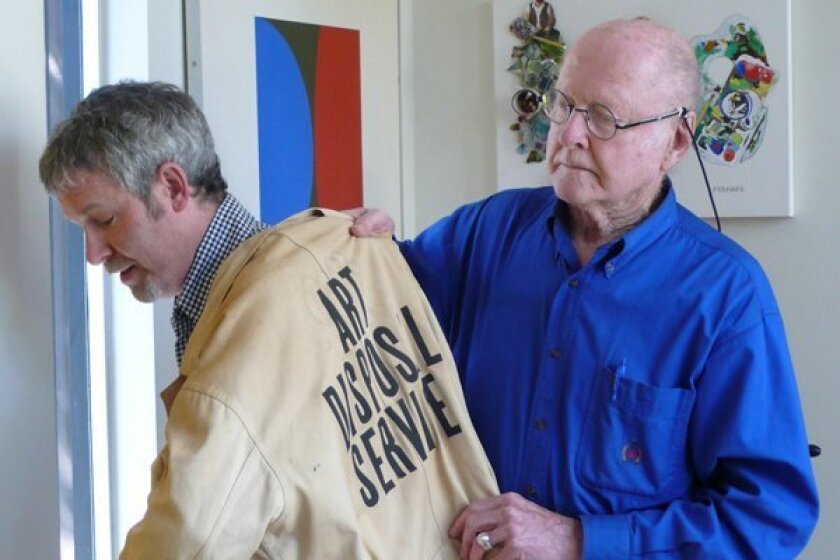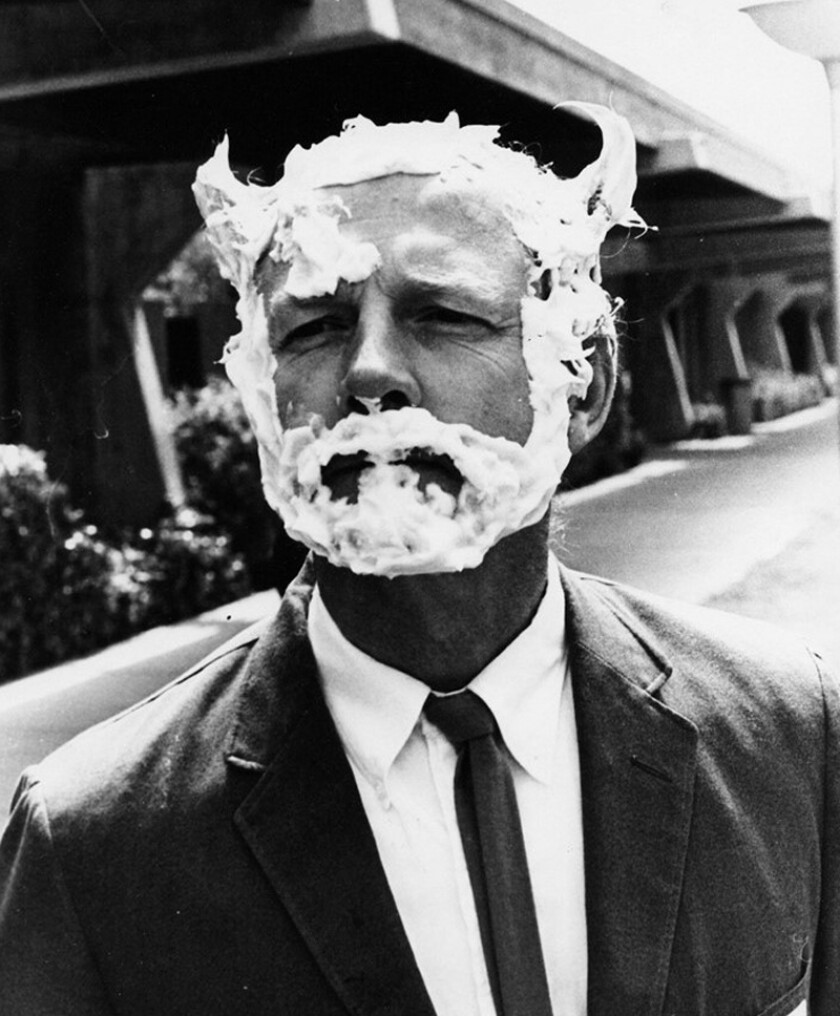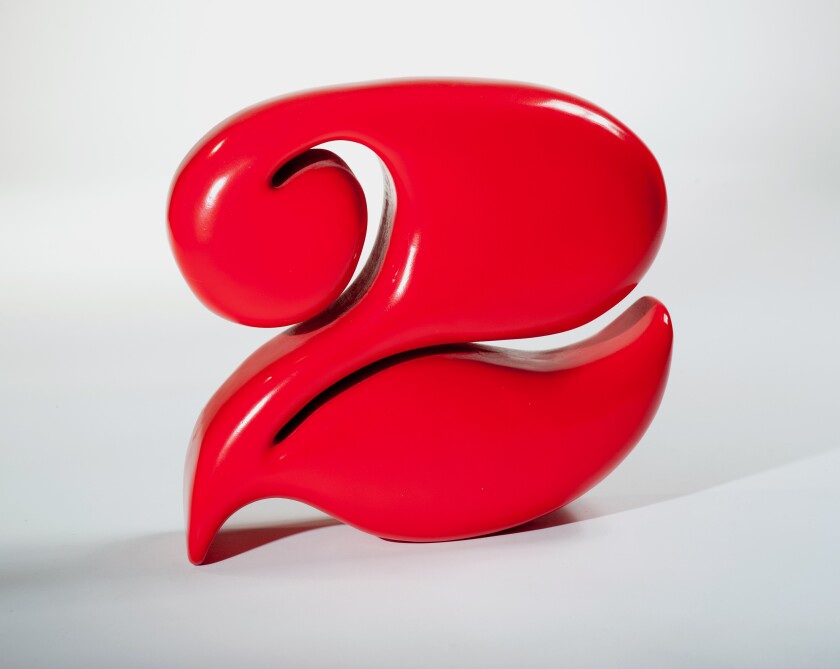Bob Matheny — the local conceptual artist, curator and educator best known for helping to define the San Diego art scene in the 1960s and ’70s alongside contemporaries such as Richard Allen Morris and John Baldessari — passed away on May 13 in his Sunset Cliffs home. He was 91.
Matheny likely would have hated the paragraph above. For an artist so prolific, so important to the local art scene, it’s tempting to think he would have wanted any posthumous tribute to be similar to his approach to art itself: see the canvas, peruse an empty space, stare at a blank page, and imagine the possibilities.
Matheny — born Robert Earl Matheny in Santa Ana, Calif., in 1929 — was so many things to so many people, and any attempt to encapsulate it all would be an exercise in futility. He was, if anything, the following things: A father and a friend; an influencer and an agitator; a protector and a provocateur; a collector and a collectivist; an exhibitionist and a humble commoner.
But for those who knew him, Matheny was, above all else, a prolific artist whose local legacy spanned multiple generations. It’s one thing to discuss the multi-faceted, multi-discipline works he created — everything from graphic design and sculpture, to paintings and photography — it’s quite another to try to capture his true artistic impact.
Advertisement
“His great gift was his facilitation of others,” says Steve Gibson, a local artist who has known Matheny since the early ’70s. “It wasn’t necessarily his art, although he made some wonderful, beautiful things. He was always interested in others and wanted to buy their work, or wanted to have their work shown or to show with them. He opened his door wide for people.”
That figurative door opened shortly after Matheny moved to San Diego in 1958 after graduating from Long Beach State College — now known as California State University Long Beach — with a master’s degree in art education. Once here, he began working as a graphic designer for the Convair Astronautics Division of General Dynamics and the Navy Electronics Laboratory.
While this work was fruitful, producing gorgeous prints of defense industry and aeronautical machinations, it was also around this time that Matheny began doing his own experiments in small press printing and, later, paintings and wooden sculptures of words, letters and punctuation marks.
“Bob was a modernist through and through,” says Dave Hampton, an art historian and curator who met Matheny on a midcentury-modern home tour in 2003. “He made modern furniture. He lived in a modern house. His graphic design totally carries through that midcentury-modern design ethos.”
Advertisement

Artist Bob Matheny passes the torch (or at least the uniform) for Art Disposal Service to Dave Hampton.
This ethos continued when Matheny began teaching at Southwestern College in Chula Vista in 1961, where he would continue to work for the next 30 years before retiring in 1991. While there, he oversaw the opening of the college’s eponymous art gallery, curating and exhibiting alongside contemporaries such as John Baldessari, Richard Allen Morris and Russell Baldwin. While those artists became more widely known in the international art world, Baldessari later remarked that those early shows helped form their practices. Baldessari even stated outright that if Matheny hadn’t facilitated them, “none of that stuff would have happened.”
This facilitation continued throughout Matheny’s tenure at Southwestern College, where he challenged students, faculty and colleagues alike to expand their concepts of acceptable art practices. One such idiosyncratic instance was his formation of a San Diego chapter of the Art Disposal Service, an offshoot of a project created by L.A. artist John Manno, that encouraged artists to take their excess works to the dump.
“It’s almost impossible to get artists to dispose of their own work because of, you know, the ego,” Matheny told KPBS in 2013.
Advertisement
The above quote is highly ironic considering that Matheny was, by almost all accounts, an avid producer and collector. Even while exhibiting his own work in prestigious institutions such as the Museum of Contemporary Art San Diego and the Los Angeles Municipal Art Gallery, Matheny remained decidedly approachable, which resulted in a vast and varied collection of art.
Art critic Robert Pincus says it was exactly that humbleness that made Matheny so influential.
“I found him to be this remarkably versatile and interesting artist who was really not a self-promoter,” says Pincus, who reviewed Matheny’s last Southwestern exhibition, “Bob Matheny, Dilettante: 1961-1991: Retrospective, Retirement, Beginning” for the Union-Tribune. In the 1991 column, he referred to Matheny as “a sublime prankster of the Dada sort.”
“He was more of a significant artist than he ever led on or that other people gave him credit for,” Pincus continues. “He cared more about just following his passions, and I noticed that to a huge degree after he retired.”
Advertisement

Bob Matheny: “Untitled” (from The Personification of Marcel Duchamp), 1972, digital print
(Courtesy of the artist. Photo by Bob Schneider)
Indeed, retirement hardly slowed Matheny down. He continued to produce conceptual pieces throughout the 1990s and into the 2000s, when his work became more loose and instinctive rather than adhering to modern aesthetics. He continued to exhibit in prestigious galleries and also started his own gallery of sorts in the alley adjacent to his home, where he’d often leave pieces to be taken by anyone who wanted them. He also began what one might consider a late-life renaissance, staging exhibitions, performances and even starting his own art space inside the Bread & Salt art space in Logan Heights. It was commonplace to spot him at an exhibition, encouragingly chatting with younger artists.
“I was just tickled by his personality when I met him, not knowing his story or who he was. He was just a human being,” says Barbara Smith, a graphic designer and art teacher who met Matheny when he contributed an anonymous, Duchamp-style piece to be auctioned off at the “Nasty Women” group show in 2017. Matheny later asked Smith to design the poster for his own exhibition of stand-alone canes at Helmuth Projects in Bankers Hill.
But the cane show was hardly Matheny’s last hurrah. In late 2018, the San Diego History Center opened “Bob Matheny: Almost Anonymous,” a decades-spanning retrospective that included over 70 works. From his early experiments in printmaking to the paintings he continued to produce toward the end of his life, the exhibition was a testament to Matheny’s understated, but nonetheless important, contribution to the San Diego art scene.
Advertisement
“I think he set an example for all of us to follow,” says Kaytie Johnson, who curated the “Almost Anonymous” exhibition. “I think that you can loop it back to his time as a teacher, because he carried that example of teaching and generosity throughout his lifetime. He showed us how important it is to support artists. He showed us the most generous way to be. That’s truly his legacy.”
Matheny was preceded in death by his wife, Norene, and is survived by his two children, Mary Ann Garner and David Matheny. Services and a celebration of life are pending.
Combs is a freelance writer.

“Two,” 1965, carved redwood and enamel.
(Photo by Chip Morton. Courtesy of the Estate of Robert Matheny)
Advertisement
"artist" - Google News
May 16, 2020 at 07:45AM
https://ift.tt/2WYkPQ4
Obituary: San Diego artist Bob Matheny dies at 91 - The San Diego Union-Tribune
"artist" - Google News
https://ift.tt/2FwLdIu
Bagikan Berita Ini














0 Response to "Obituary: San Diego artist Bob Matheny dies at 91 - The San Diego Union-Tribune"
Post a Comment